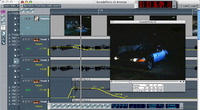 Much of what a Production Mixer does is based upon his or her assessment of what will be needed later on during post-production (editing & final mixdown). With that in mind, let’s begin with a brief overview of “post” and work our way back to the production side of things. Key elements include Narration, Music, Sound Effects, and Dialogue.
Much of what a Production Mixer does is based upon his or her assessment of what will be needed later on during post-production (editing & final mixdown). With that in mind, let’s begin with a brief overview of “post” and work our way back to the production side of things. Key elements include Narration, Music, Sound Effects, and Dialogue.
What types of sound make up a motion picture or video soundtrack?
Narration (N, NARR, VO)
Many films rely heavily on NARRATION to hold the visuals together or to provide explanation. All of us, I’m sure, are familiar with documentaries, travelogues, and educational films that employ Narration as the primary element of the soundtrack. Don’t forget, however, that many theatrical films also use Narration as a story device—sometimes in the role of an ‘anonymous’ storyteller, sometimes as the inner thoughts of a principal character.
Narration can be recorded in two different ways.
The first way, or style, is to have the narrator view the film and record live commentary while it is projected. The lines may be from a script or totally improvised, depending on the film in question. This style is referred to as “sync to picture”. As you have guessed, it is quite common to travelogues! The other approach, which is usually the preferred way of doing it, involves recording the narration “wild” from a script, instead of from watching the picture. The talent reads the lines from a prepared script, which are recorded as isolated takes. (Note, while it is true that some narrators may view the film in preparation of the recording session, the picture does not play a role during the session itself.) An editor then cuts the desired lines in place opposite the appropriate footage.
This method gives the filmmaker maximum creative control over the relationship between picture and narration, and allows greater flexibility should editorial changes be desired later on. It also frees the narrator to concentrate on enunciation and delivery of the lines, rather than worrying about matching whatever is up on screen that moment.
Narration tracks can physically be recorded either in a professional recording studio (with full acoustic isolation from any outside noise), or as a “wild track” while on location. Which technique is used depends on knowing how the narration is to intercut with the rest of the soundtrack.
If the narration is supposed to be authoritative and ‘anonymous’ (commonly nicknamed the “voice of God” approach) — then isolated studio recording is called for. The voice track is recorded with a full presence, completely free of any ambient background noise or room coloration (room echo or bounce).
On the other hand, if the narration is supposed to be degetic, in other words, a “continuation” of on-screen dialogue or on-screen explanation—then the narration is usually recorded as a “wild track” (camera is not shooting) at the same location. The sound quality of the wild lines should match closely with the sound quality of the original on-screen portion of the dialogue. Perspective and presence should be similar. Background ambiance and room acoustics should also match. The goal is to convince the audience that the narration is an uninterrupted continuation of the talking head they saw at the beginning, even though the visuals have cut away to instructional inserts.
It is true, however, that often the sound mixer will be asked to record “voice of God” narration as well as “wild lines” while out on location, due to limited availability of some actors (or limitations of the budget). This, though, becomes more a matter of technique in “faking it” (to sound like an isolated recording studio).
